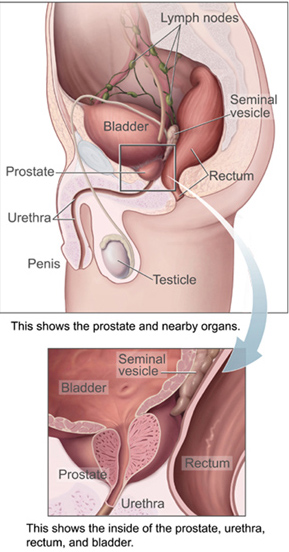Related Research Articles

The prostate is both an accessory gland of the male reproductive system and a muscle-driven mechanical switch between urination and ejaculation. It is found in all male mammals. It differs between species anatomically, chemically, and physiologically. Anatomically, the prostate is found below the bladder, with the urethra passing through it. It is described in gross anatomy as consisting of lobes and in microanatomy by zone. It is surrounded by an elastic, fibromuscular capsule and contains glandular tissue, as well as connective tissue.

Penis enlargement, or male enhancement, is any technique aimed to increase the size of a human penis. Some methods aim to increase total length, others the shaft's girth, and yet others the glans size. Techniques include surgery, supplements, ointments, patches, and physical methods like pumping, jelqing, and traction.

Urethral sounding is the practice of inserting objects into the urethra for sexual gratification. Urethral dilatation is a urological procedure that uses probes called sounds to enlarge the inside diameter of the urethra and locate obstructions in the urethra, or as a treatment for urethral strictures.

Metoidioplasty, metaoidioplasty, or metaidoioplasty is a female-to-male gender-affirming surgery.
Urethral meatal stenosis is a narrowing (stenosis) of the opening of the urethra at the external meatus, thus constricting the opening through which urine leaves the body from the urinary bladder.

The Reverse Prince Albert piercing (RPA) is a form of male genital piercing.

A nephrectomy is the surgical removal of a kidney, performed to treat a number of kidney diseases including kidney cancer. It is also done to remove a normal healthy kidney from a living or deceased donor, which is part of a kidney transplant procedure.

The external anal sphincter is an oval tube of skeletal muscle fibers. Distally, it is adherent to the skin surrounding the margin of the anus. It exhibits a resting state of tonical contraction and also contracts during the bulbospongiosus reflex.

A suprapubic cystostomy or suprapubic catheter (SPC) is a surgically created connection between the urinary bladder and the skin used to drain urine from the bladder in individuals with obstruction of normal urinary flow. The connection does not go through the abdominal cavity.
Odynorgasmia, or painful ejaculation, also referred to as dysejaculation, dysorgasmia, and orgasmalgia, is a physical syndrome described by pain or burning sensation of the urethra or perineum during or following ejaculation. Causes include: infections associated with urethritis, prostatitis, epididymitis; use of anti-depressants; cancer of the prostate or of other related structures; calculi or cysts obstructing related structures; trauma to the region.

The corona of glans penis or penis crown refers to the rounded projecting border or flare that forms at the base of the glans in human males. The corona overhangs a mucosal surface, known as the neck of the penis, which separates the shaft and the glans. The deep retro-glandular coronal sulcus forms between the corona and the neck of the penis. The two sides of the corona merge on the ventral midline forming the septum glandis. The circumference of the corona is richly innervated and is described as a highly erogenous area of the glans.
The bulbocavernosus reflex (BCR), bulbospongiosus reflex (BSR) or "Osinski reflex" is a polysynaptic reflex that is useful in testing for spinal shock and gaining information about the state of spinal cord injuries (SCI). Bulbocavernosus is an older term for bulbospongiosus, thus this reflex may also be referred to as the bulbospongiosus reflex.
Lower urinary tract symptoms (LUTS) refer to a group of clinical symptoms involving the bladder, urinary sphincter, urethra and, in men, the prostate. The term is more commonly applied to men – over 40% of older men are affected – but lower urinary tract symptoms also affect women. The condition is also termed prostatism in men, but LUTS is preferred.
Douglas S. Scherr, M.D. is an American surgeon and specialist in Urologic Oncology. He is currently the Clinical Director of Urologic Oncology at Weill Cornell Medicine. He also holds an appointment at the Rockefeller University as a Visiting Associate Physician. Scherr was the first physician at Cornell to perform a robotic prostatectomy as well as a robotic cystectomy.

Ejaculation is the discharge of semen from the male reproductive tract. It is normally linked with orgasm, which involves involuntary contractions of the pelvic floor. It is the final stage and natural objective of male sexual stimulation, and an essential component of natural conception. Ejaculation can occur spontaneously during sleep, and is a normal part of human sexual development. In rare cases, ejaculation occurs because of prostatic disease. Anejaculation is the condition of being unable to ejaculate. Ejaculation is normally intensely pleasurable for men; dysejaculation is an ejaculation that is painful or uncomfortable. Retrograde ejaculation is the condition where semen travels backwards into the bladder rather than out of the urethra.
Doctors have documented numerous cases of insertion of foreign bodies into the urethra, typically as the result of auto-erotic activities. This can result in infections and serious internal bleeding.
A urethral diverticulum is a condition where the urethra or the periurethral glands push into the connective tissue layers (fascia) that surround it.

Miroslav L Djordjevic is a Serbian surgeon specializing in sex reassignment surgery, and an assistant professor of urology at the School of Medicine, University of Belgrade, Serbia.
A penis extender is an external medical device with tentative evidence as of 2019 for Peyronie's disease. It acts as a mechanical, traction device that stretches the human penis in the flaccid state to make it longer.
Anthony James Costello, FRACS, FRCSI, is an Australian urologist. He served as head of the department of urology at the Royal Melbourne Hospital, Australia. He established the first robotic prostate cancer surgery programme in Australia and published the first series of men who had laser surgery for benign prostate enlargements.
References
- ↑ "Urethrectomy (removal of the male urethra)" (PDF). British Association of Urological Surgeons. September 2017. Retrieved 25 December 2017.
- ↑ Van Poppel, Hein; Joniau, Steven; Groen, Luitzen-Albert (January 2009). "Prepubic urethrectomy". BJU International. 103 (1): 118–132. doi:10.1111/j.1464-410X.2008.08201.x. PMID 19076974.
- ↑ Van Poppel, Hein; Joniau, Steven; Groen, Luitzen-Albert (January 2009). "Prepubic urethrectomy". BJU International. 103 (1): 118–132. doi:10.1111/j.1464-410X.2008.08201.x. PMID 19076974.